This is the website of Abulsme Noibatno Itramne (also known as Sam Minter).
Posts here are rare these days. For current stuff, follow me on Mastodon
|
The Iowa results on the Republican side were officially certified on Wednesday, earlier than anybody expected, and with a surprise. Almost every source believed 27 delegates would be decided by the caucus results, but the remaining 3 “automatic delegates” who are party leaders, would attend the convention unbound and able to support whoever they wished. But it looks like those three delegates will be bound by the caucus results as well.
When you do the required math on 30 delegates instead of 27, everything remains the same, except Huckabee gets a delegate too.
Updating the chart showing the “% of remaining needed to win” graph:
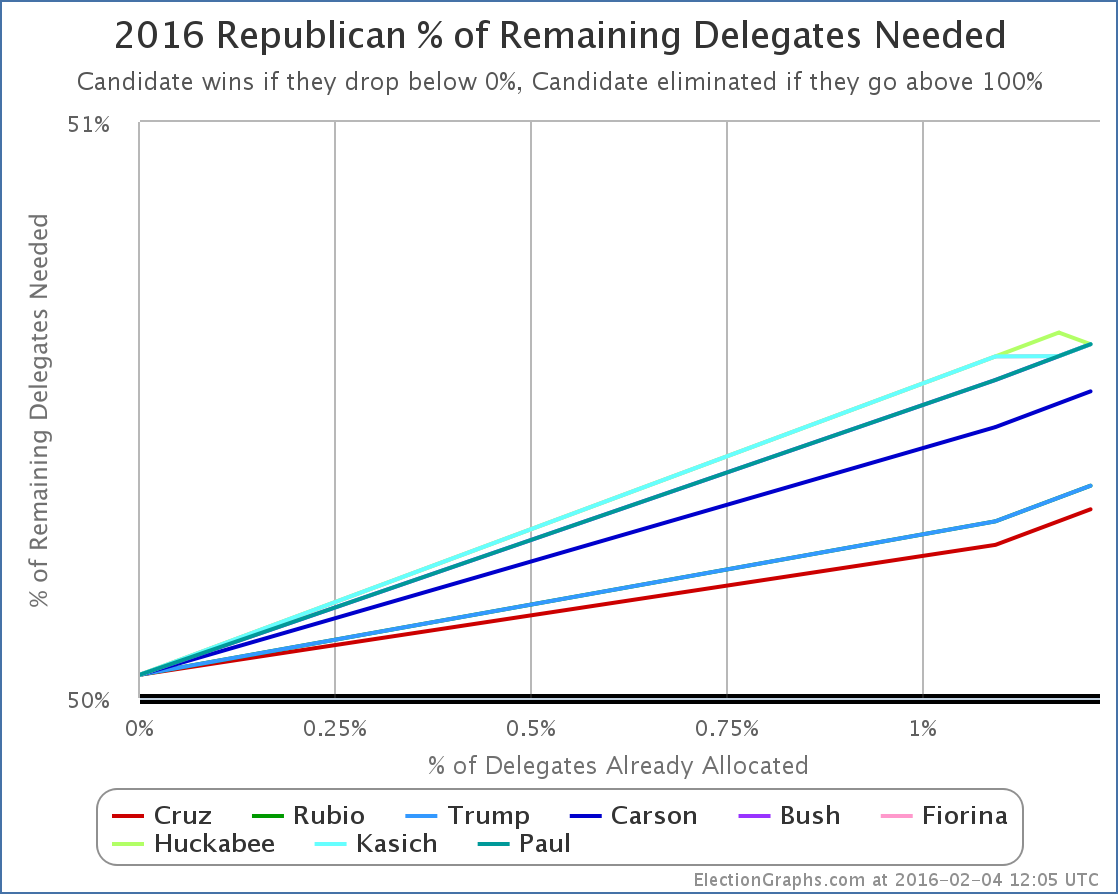
And the raw numbers:
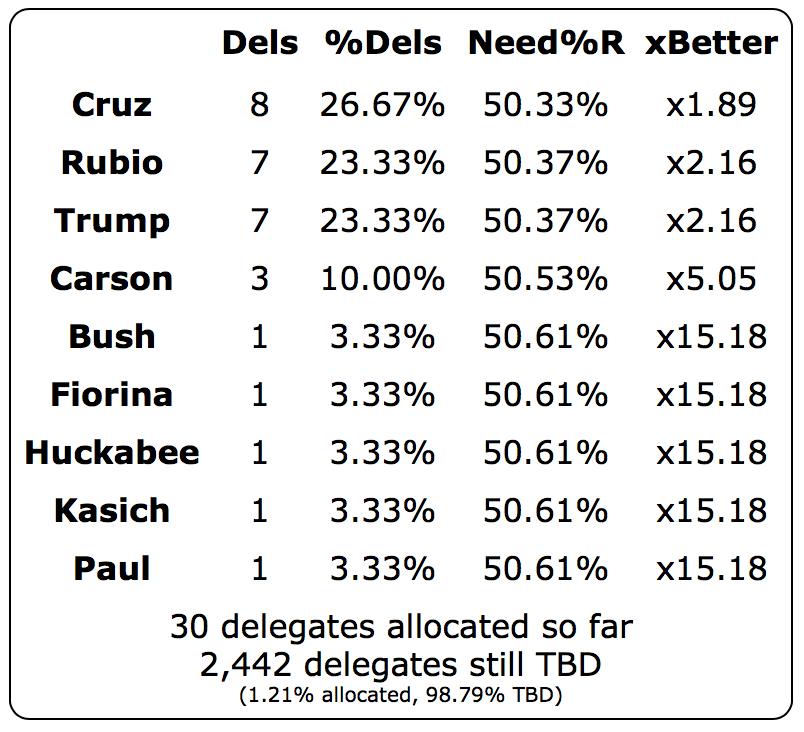
Huckabee and Paul have suspended their campaigns, but since these are bound delegates, they keep them unless the candidates officially release them. I haven’t seen a report of that yet, so won’t remove them from the list at this point. Not that it matters much for single delegates. This is a much more important factor when candidates drop out later in the race once they have already accumulated a significantly sized chunk of delegates.
Huckabee’s one delegate makes no difference to the analysis I posted Tuesday or the follow up from Wednesday.
We still have three candidates showing strength going into New Hampshire It is within the realm of possibility that New Hampshire will add a fourth to that list, but just as likely it will solidify the “three way race” picture. And as I outlined in the Wednesday post the specific New Hampshire delegate rules matter a lot. Specifically the rules essentially give extra bonus delegates to the winner, and don’t allow delegates at all for anyone coming in under 10%. This is a recipe to transform a plurality win to a healthy delegate majority.
So if you are watching the polls as they start to include post-Iowa data, watch carefully not only who is in the lead, but exactly who is above or below the 10% threshold, because that will make a huge difference in the delegate counts.
And an 8-7-7 split with only 1.21% of delegates determined is essentially a tie. And a tie that will soon be overwhelmed numerically by the results from New Hampshire and beyond. So don’t get sucked too deeply into the spin from all quarters taking about who is up and who is doomed. It is still too early for that. (Well, at least if you don’t drop out.)
Five days until New Hampshire.
Note: This post is an update based on the data on ElectionGraphs.com. Election Graphs tracks both a poll based estimate of the Electoral College and a numbers based look at the Delegate Races. All of the charts and graphs seen in this post are from that site. Additional graphs, charts and raw data can be found there. All charts above are clickable to go to the current version of the detail page the chart is from, which may contain more up to date information than the snapshots on this page, which were current as of the time of this post. Follow @ElectionGraphs on Twitter or like Election Graphs on Facebook to see announcements of updates or to join the conversation. For those interested in individual general election poll updates, follow @ElecCollPolls on Twitter for all the polls as they are added.
We made it past Iowa! We have Iowa results! We have brand new speculation about New Hampshire and beyond! Yes, of course, the bulk of this week’s Curmudgeon’s Corner podcast is Sam and Ivan discussing where the presidential race sits in this week between Iowa and New Hampshire. We go over all of the results so far, then discuss how candidates, the media and the public are reacting to those results, and what that means for the rest of the contest. Plus, for the first time in a little while, we do a lightning round as well, covering bluetooth audio issues, Iran, the Flint water crisis, tech earnings results, and more!
Click below to listen or subscribe… then let us know your own thoughts!

Recorded 2016-02-04
Length this week – 2:12:09
 1-Click Subscribe in iTunes 1-Click Subscribe in iTunes
 View Podcast in iTunes View Podcast in iTunes
 View Raw Podcast Feed View Raw Podcast Feed
 Download MP3 File Download MP3 File
 Follow the podcast on Facebook Follow the podcast on Facebook
Show Details:
- (0:00:10-0:05:11) Intro
- Pi O’Clock Again
- Agenda
- Talking Politics
- (0:06:00-0:29:42) Republicans in Iowa
- Loser.com
- Headlines
- Delegate Totals
- Spin
- Polling Wrong?
- People Dropping Out
- Carson/Cruz blow up
- Speeches
- (0:30:45-0:43:55) Democrats in Iowa
- Close Race
- Not a Surprise
- Delegate Totals
- Spin
- Demographic Split
- (0:44:33-1:24:33) Republicans in New Hampshire and beyond
- Delegate Rules
- Delegate Hypothetical
- Will we get good New Hampshire polls?
- Contest Calendar
- Trump reacts to losing
- How will New Hampshire react to Iowa?
- Divided anti-Trump vote
- Trump Strategy
- Bush done?
- Big last minute moves?
- Gilmore
- post-New Hampshire
- Predictions
- (1:25:53-1:42:08) Democrats in New Hampshire and beyond
- Sanders will win New Hampshire
- post-New Hampshire
- Delegate Allocation
- How will Clinton react to losing?
- No Clinton Backup
- Clinton emails
- Clinton collapse scenarios
- (1:43:24-2:11:49) Lightning Round
- Car Bluetooth Audio
- Movie: Thomas and the Magic Railroad (2000)
- Iran Deal Implementation
- Flint Water Crisis
- Oregon Militia Standoff Ended
- Apple Earnings
- Alphabet Market Cap
- Feedback on Performance Reviews
- Feedback on Sam’s Writing
- Growing Show
Yesterday’s update was preliminary, and I ended up using the delegate estimates provided by the AP which were used at the New York Times, Washington Post, and other places. My favorite source, Green Papers, had a different set of numbers. When I tried to calculate delegate numbers myself, I came up with yet another set of numbers. I ended up going with the AP numbers.
A little more than a day later and Green Papers updated, now matching what I had calculated myself. So I’m updating the estimates accordingly.
This moves us from:
8 Cruz, 7 Trump, 7 Rubio, 3 Carson, 1 Bush, 1 Paul
to
7 Cruz, 7 Trump, 6 Rubio, 3 Carson, 1 Bush, 1 Fiorina, 1 Kasich, 1 Paul.
The main change here is one less delegate each to Cruz and Rubio, with those delegates picked up at the bottom end by Fiorina and Kasich.
But wait! There is more! The Washington Post and Politico both add two additional delegates. The 27 allocated by the caucus results were already accounted for, so these would be two of the three “party leaders” who end up as automatic delegates. No indication of which party leader did what, but they add one additional delegate each to Cruz and Rubio.
The new Iowa totals become:
8 Cruz, 7 Rubio, 7 Trump, 3 Carson, 1 Bush, 1 Fiorina, 1 Kasich, 1 Paul.
Between these two changes, the net is simply adding the delegates for Fiorina and Kasich. This means 29 of the 30 Iowa delegates are now accounted for.
Note that even though Paul has “suspended his campaign”, he keeps his delegate unless he explicitly releases it.
The raw delegate count chart now looks like this:
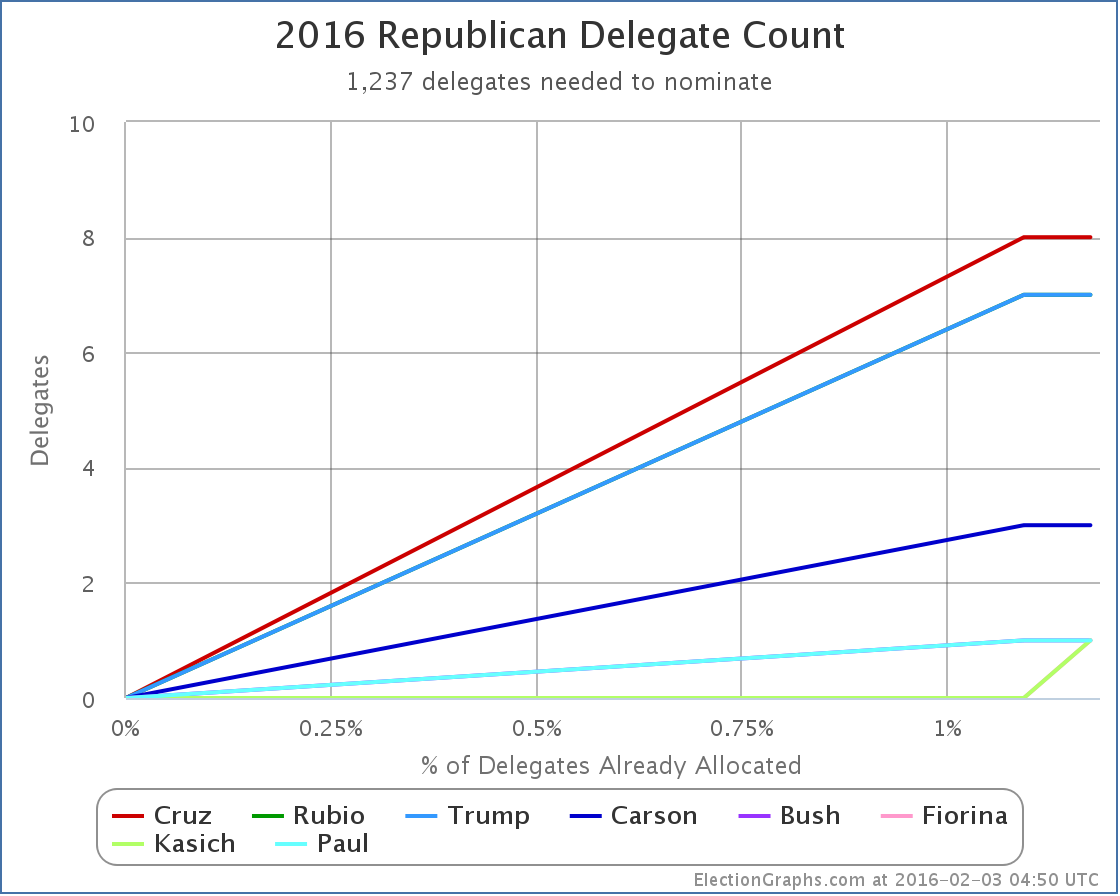
Just a little uptick at the end for Fiorina and Kasich to join Bush and Paul at the 1 delegate mark.
Flipping this over to look at “% of remaining needed to win”:
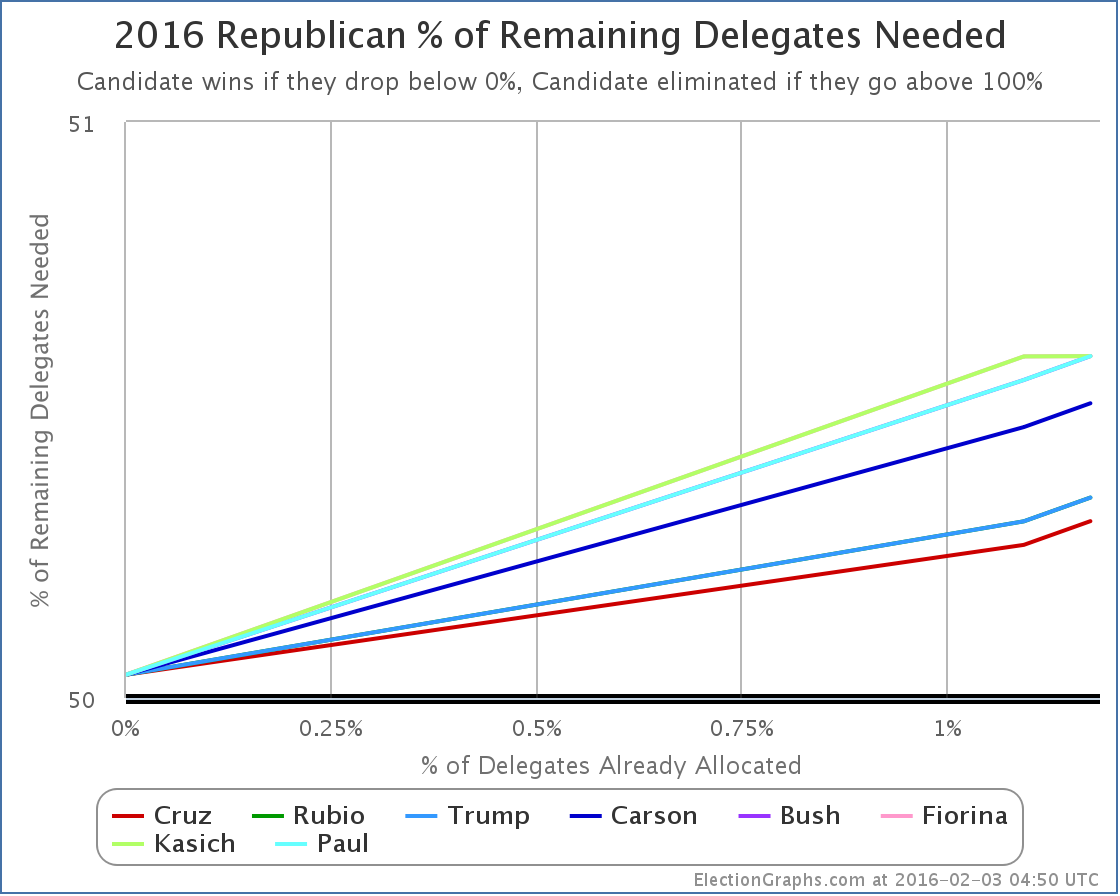
On this chart, lower is better. When you get down to 0% you win. If you get to 100% you are eliminated. Everybody is still heading upward, not downward, but it is still very early. The whole field here ranges from needing 50.31% of the remaining delegates, to needing 50.59% of the remaining delegates.
Looking specifically at New Hampshire, there are 20 delegates at stake. We are so early, and the % needed numbers so close, that this is easy. The number needed to be on track to win is 11 delegates. Anything less, and the candidate is actually going to be in a harder position in the next contest rather than an easier one.
Let’s game out New Hampshire based on the current RCP averages. Yes, yes, this is based on polling before New Hampshire. Things will change in the next six days. But this is just to model how it works.
The rules via The Green Papers:
- 20 National Convention delegates are to be bound proportionally to presidential contenders based on the primary vote statewide.
- A 10% threshold is required in order for a presidential contender to be allocated National Convention delegates.
- Allocate delegates based on the 20 Г— candidate’s vote Г· total statewide vote. Round to the nearest whole number.
- Any delegate positions that remain open are awarded to the candidate with the highest statewide vote total.
Assume each candidate gets exactly their poll average today. Only the candidates over 10% matter, so with RCP as of right now that is:
33.4% Trump, 12.2% Cruz, 10.8% Rubio, 10.4% Kasich
Converting this to delegates with the rounding rules above, you get:
7 Trump, 2 Cruz, 2 Kasich, 2 Rubio
This is only 13, so there are 7 delegates left. According to the last rule, these all go to the leader, so we end up with:
14 Trump, 2 Cruz, 2 Kasich, 2 Rubio
And therefore Trump would get 70% of the delegates despite only getting 33.7% of the vote. Trump’s line on the “% needed to win” would go down, while everybody else would go up.
After this hypothetical New Hampshire result, the overall race would be:
21 Trump, 10 Cruz, 9 Rubio, 3 Carson, 3 Kasich, 1 Bush, 1 Paul, 1 Fiorina.
Trump would still only have 42.9% of the delegates, which is not a majority, but Cruz would be way back at 20.4% and you’d have Trump starting to pull away from the pack. Still only 1.98% of delegates allocated at that point though, with lots of room for further changes.
The RCP average on February 3rd is NOT going to look like the actual results on Primary night. This is just an example.
The points to take away:
- The detailed delegate rules matter, you don’t necessarily have to win a popular vote majority to win a delegate majority.
- We’re still so very early, one contest can have a major effect on the delegate totals, and each state is very different, so don’t put much stock in extrapolating Iowa to future contests.
Of course New Hampshire will be here soon enough, and we’ll do this with the real results.
Note: This post is an update based on the data on ElectionGraphs.com. Election Graphs tracks both a poll based estimate of the Electoral College and a numbers based look at the Delegate Races. All of the charts and graphs seen in this post are from that site. Additional graphs, charts and raw data can be found there. All charts above are clickable to go to the current version of the detail page the chart is from, which may contain more up to date information than the snapshots on this page, which were current as of the time of this post. Follow @ElectionGraphs on Twitter or like Election Graphs on Facebook to see announcements of updates or to join the conversation. For those interested in individual general election poll updates, follow @ElecCollPolls on Twitter for all the polls as they are added.
Unlike the Democrats, the Republicans didn’t have years of superdelegates endorsing one candidate or another, so Iowa really was a clean slate. The very first delegates earned in the race for the 2016 Republican nomination. The headlines are of course that Trump underperformed the poll-based expectations letting Cruz slide to a win, while Rubio outperformed his expectations, coming in a close third. This is all true.
But it is also true that only a tiny fraction of the delegates have been allocated so far. None of the candidates got a majority in Iowa either. So nobody is actually yet on a track to overall victory. Cruz may be slightly ahead, but Trump and Rubio are right at his heels. Cruz is not in a dominating position. It really is a three person race.
Looking at the raw delegate graph quickly…
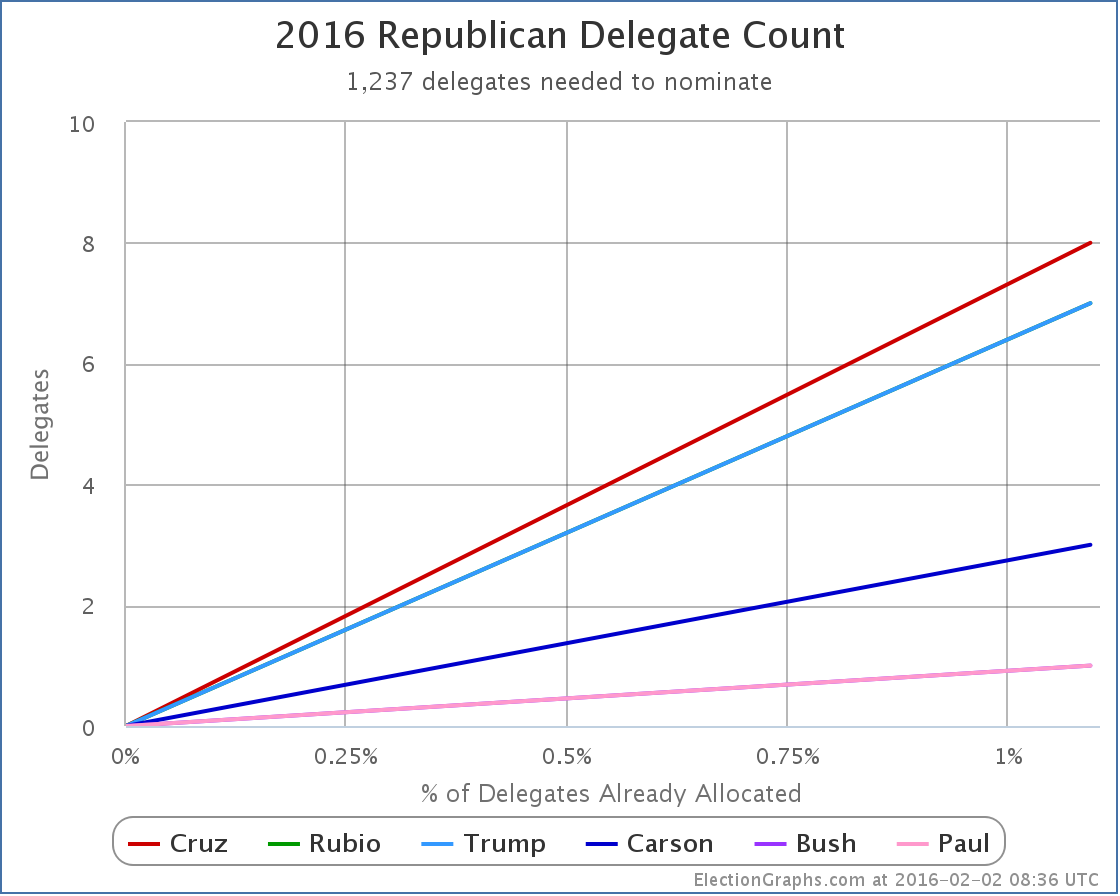
…you immediately notice that we just have a really boring graph with a few straight lines. And Rubio’s line and Trump’s line completely overlap too. As do Bush and Paul’s lines. That’s because this is our first real data point after everyone was just at zero.
All of the graphs are like this. So just this once, lets skip the graphs and look at the summary table instead:
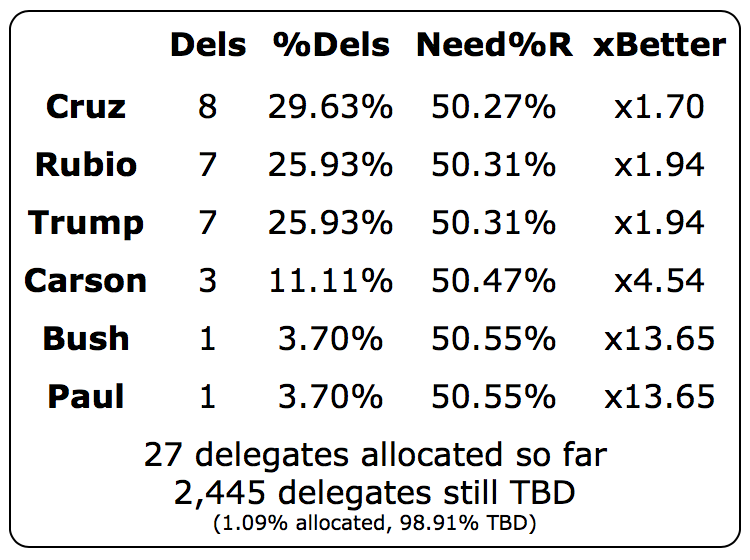
I’ll note here that Green Papers has slightly different numbers. But the New York Times, Washington Post, and CNN all agree with the estimates above, so for the moment that is what we’ll go with here.
It is clear that Cruz/Rubio/Trump are in a separate class here than Carson/Bush/Paul. But even these three would need to nearly double their performance to actually be on a track to win, because, well, you have to be getting more than half of the delegates to win outright. 25% to 30% won’t get you there. So at some point, somebody has to start going over the 50% mark if there is going to be a winner.
There is plenty of time for that of course. Nobody is predicting a contested convention quite yet, as much fun as that would be.
We probably won’t see anyone over 50% after New Hampshire either, but how close we get may depend on the viability thresholds. In New Hampshire on the Republican side you need to get 10% of the popular vote to be eligible for delegates. Although this will definitely change in response to the Iowa results, at the moment RCP has Trump at 33.2%, Cruz at 11.5%, Kasich at 11.5%, Bush at 10.3%, and Rubio at 9.5%. The rest are pretty far from 10%. But that is four candidates all within a couple percent of 10%.
Depending on which of those ends up right above or right below the 10% threshold, you could see very different delegate results coming out of New Hampshire. Most likely, we’ll have three or four candidates over 10% and a mix of delegates, but in the extreme case, if all but Trump drops under 10%, then Trump gets all the delegates. So a wide range of things is possible based on really small movements from the current positions in the polls.
Final points here though to the people saying Iowa proves that Trump is done…
- Trump was pretty close in Iowa. A one delegate difference means almost nothing.
- Although the Iowa results may diminish it, Trump starts with a big lead in New Hampshire.
- Only 1.09% of the Republican delegates have been determined so far.
We have a three way race right now. It is not inconceivable that a 4th candidate could do well enough in New Hampshire to join that group. Things are just as up in the air and chaotic on the Republican side as they were before Iowa. Anything could still happen.
Stay tuned.
Note: This post is an update based on the data on ElectionGraphs.com. Election Graphs tracks both a poll based estimate of the Electoral College and a numbers based look at the Delegate Races. All of the charts and graphs seen in this post are from that site. Additional graphs, charts and raw data can be found there. All charts above are clickable to go to the current version of the detail page the chart is from, which may contain more up to date information than the snapshots on this page, which were current as of the time of this post. Follow @ElectionGraphs on Twitter or like Election Graphs on Facebook to see announcements of updates or to join the conversation. For those interested in individual general election poll updates, follow @ElecCollPolls on Twitter for all the polls as they are added.
The Iowa caucuses have finally come and gone, and we have the first “earned” delegate results of the nomination race. Sorta. No actual Democratic delegates were actually determined. It was just the first step in a multi stage process. But as of now, estimates can be made. The estimates as per The Green Papers are 23 delegates for Clinton and 21 for Sanders. There were also 4 Iowa superdelegates already for Clinton.
So the Iowa totals as of this post are: 27 Clinton, 21 Sanders, 4 superdelegates TBD.
Even if all 4 remaining superdelegates went for Sanders, which is unlikely, Clinton still wins Iowa 27 to 25.
This despite the predominant reporting of tonight’s results as a tie or near-tie for Sanders.
In addition, since my last post on the Democrats in other states there have been 3 additional super delegates who came out for Clinton, and 2 who came out for Sanders.
So, where does that put us? First, the raw delegate totals:
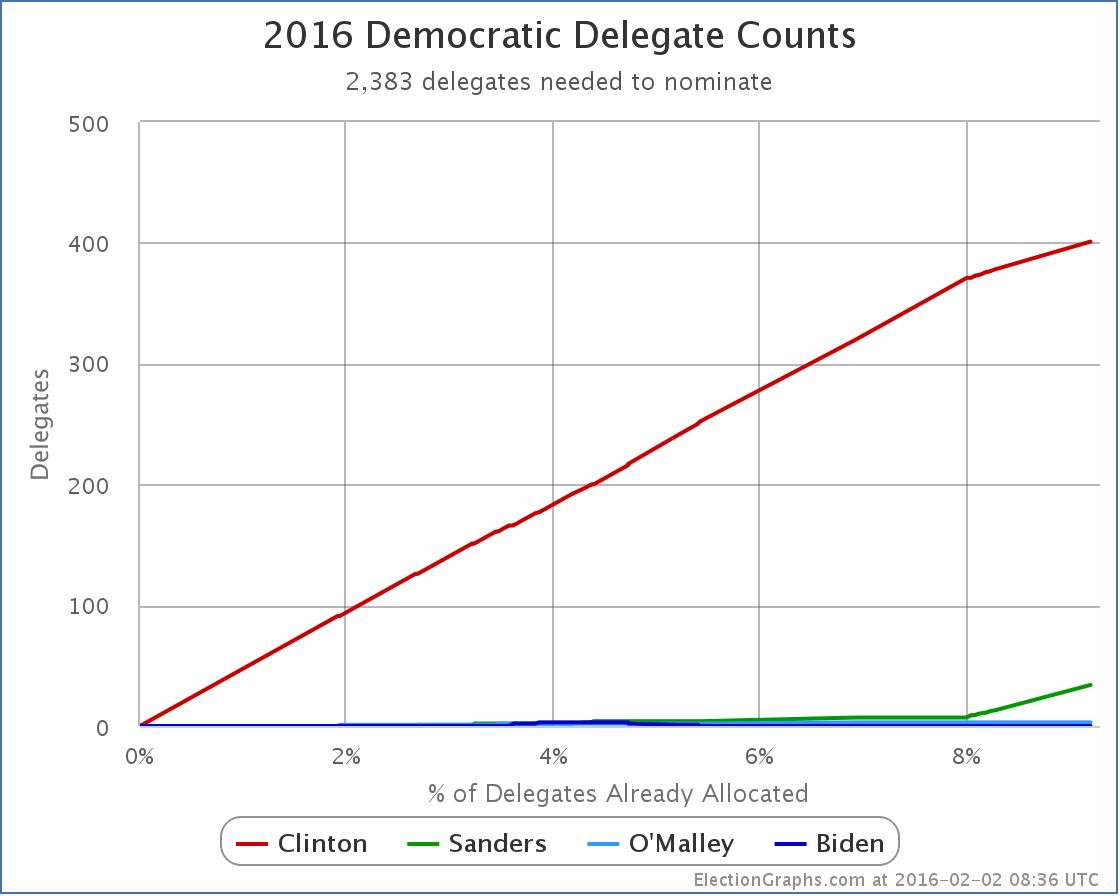
You can see the “kink” in the chart that is the result of Clinton getting a much smaller percentage of the Iowa delegates than her absolute domination in the superdelegate race. This of course means her percentage of the delegates so far takes a bit of a swoon:
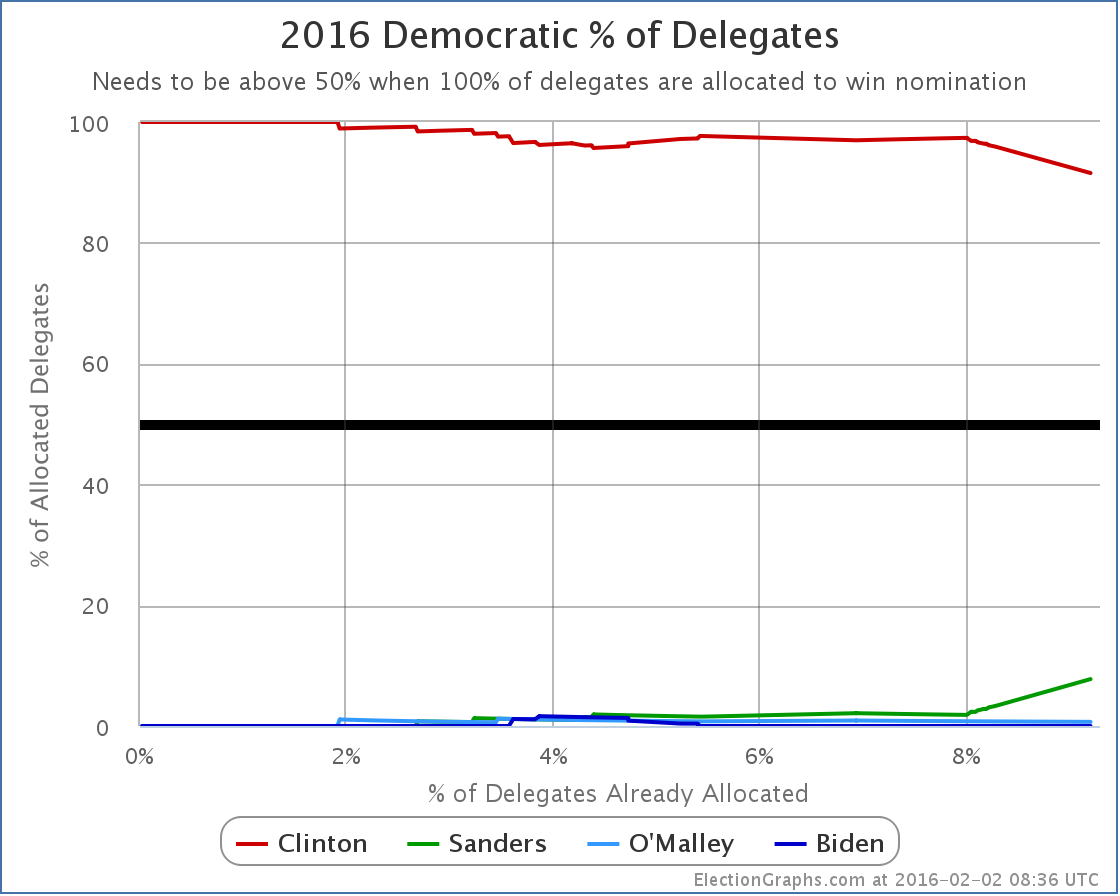
Clinton is down to only 91.55% of the delegates allocated so far! That’s the lowest she has been so far!
OK, that is down, but actually it is still pretty dominant.
But what does all this do to the critical “% of remaining delegates needed to win”?
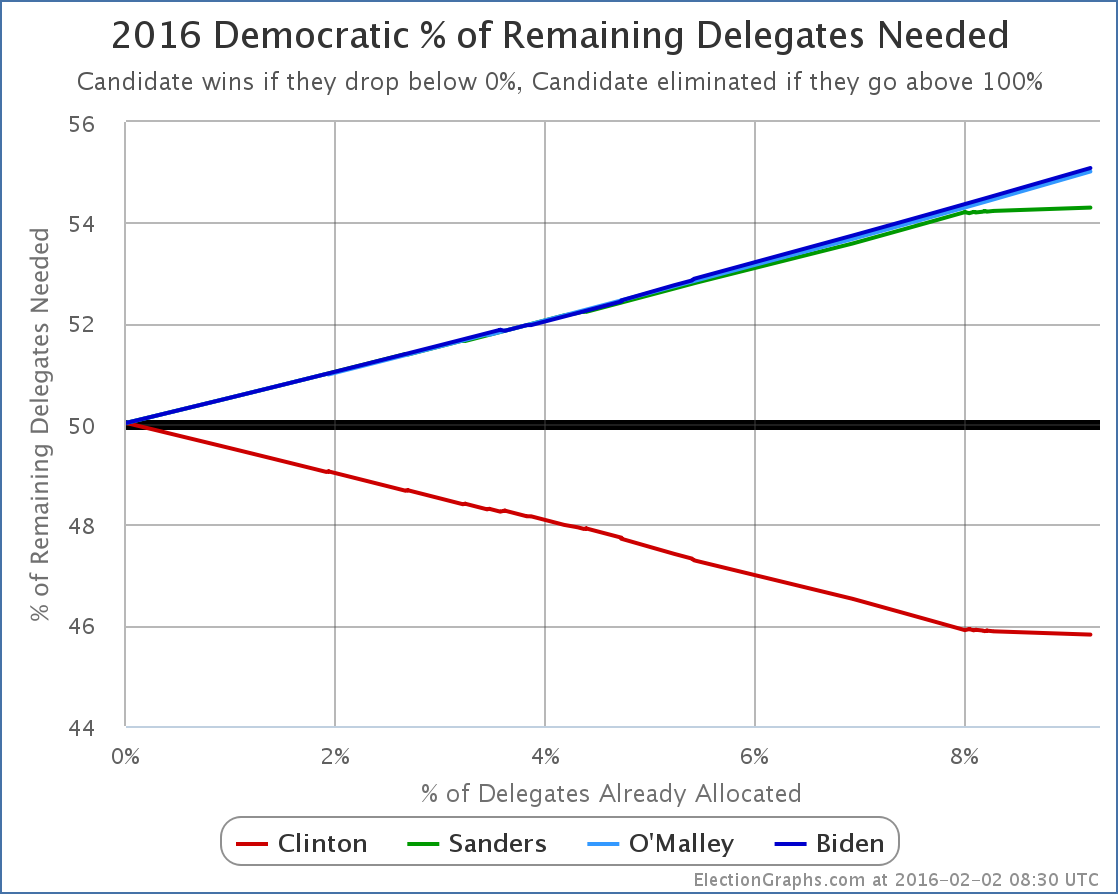
When I made the last blog update, Sanders needed 54.22% of remaining delegates to win. Right before tonight’s new Iowa results, that had moved to 54.23%. Adding in the Iowa results it is now… 54.30%. So up a little, but really not by much. Sanders did not do well enough to bring this percentage down. It has to actually go down for Sanders to be on a pace to catch up and win. But he at least did well enough to keep it from getting very much worse than it was.
Looking at the New Hampshire polling, Sanders is currently at 55.5% in the RCP average and 55.2% in the Pollster average. Either way, that is a smidgen above 54.30%. So even if he gets no boost in New Hampshire from his near tie with Clinton in Iowa, Sanders may meet the bar he needs in order to improve his numbers on this metric. He doesn’t have much leeway though. If he drops at all, then he essentially will fall even further behind after New Hampshire.
The states beyond New Hampshire of course look more hostile to Sanders based on early polling. To make any real race out of this, something would need to happen that would cause Clinton to not just do a little worse, but a lot worse. Otherwise, the rest of this Democratic race is just going to be a process of Clinton mopping up, no matter what sort of media hubbub results after a potential Sanders win in New Hampshire.
Note: This post is an update based on the data on ElectionGraphs.com. Election Graphs tracks both a poll based estimate of the Electoral College and a numbers based look at the Delegate Races. All of the charts and graphs seen in this post are from that site. Additional graphs, charts and raw data can be found there. All charts above are clickable to go to the current version of the detail page the chart is from, which may contain more up to date information than the snapshots on this page, which were current as of the time of this post. Follow @ElectionGraphs on Twitter or like Election Graphs on Facebook to see announcements of updates or to join the conversation. For those interested in individual general election poll updates, follow @ElecCollPolls on Twitter for all the polls as they are added.
Iowa is coming. Did everyone know the Iowa Caucuses are coming very soon? This week on Curmudgeon’s Corner, Sam and Ivan discuss the state of the presidential race in the lead up to the Iowa Caucuses. On the Republican side, they discuss attacks on Trump finally starting, while the rest of the candidates attack each other, as well as details of delegate allocation in Iowa, and some talk about Trump supporters commenting on Sam’s election site. On the Democratic side, it is delegate allocations again, and just how hard a path it would be for Sanders to catch up and win given Clinton’s superdelegate lead and other factors. Oh yeah, and at the start, Sam complains a bit about company annual reviews.
Click below to listen or subscribe… then let us know your own thoughts!

Recorded 2016-01-29
Length this week – 1:13:26
 1-Click Subscribe in iTunes 1-Click Subscribe in iTunes
 View Podcast in iTunes View Podcast in iTunes
 View Raw Podcast Feed View Raw Podcast Feed
 Download MP3 File Download MP3 File
 Follow the podcast on Facebook Follow the podcast on Facebook
Show Details:
- (0:00:10-0:10:22) But First
- (0:11:42-0:54:20) Election 2016 – Republicans
- Finally Iowa
- Attacking Trump
- Last Week Shifts
- Circular Firing Squad
- Conservatism vs Trumpism
- Trump skipping debate
- Trump shooting people
- Trump commenters on Election Graphs
- Republican Delegates in Iowa
- Trump Insults
- Iowa predictions
- (0:55:04-1:13:06) Election 2016 – Democrats
- Clinton will win in the end
- Democratic Delegates in Iowa
- ElectionGraphs.com Delegate Tracker
- Clinton’s big superdelegate lead
- What Sanders needs to “really” win
- Feedback – Palin Poetry
- Wrap Up
The Election Graphs delegate tracker is live! In the last few hours I have posted an intro to this effort, a tour of the new features, and a FAQ. But now it is time to get into the meat of things and start talking about results and what they mean.
While the Republican Party does have unbound delegates that will be able to make up their own minds independently, most of those people won’t be officially chosen until the primary/caucus season is well underway, and regardless, I haven’t yet found a good source of information tracking which of these folks is publicly supporting which Republican candidate. So the flow of delegate information for the Republicans won’t start until we get the results of the Iowa caucuses next week.
But on the Democratic side… most of the “superdelegates” are already known (although some may change before the convention). The superdelegates are Governors, Senators, Representatives, members of the Democratic National Committee, and “Distinguished Party Leaders”. As Democratic activists, these people very often are quite public about who they support. And they show up in news reports when they do that. And there are places tracking it.
Since this is the first analysis post of the primary season, I’m going to walk through the charts I use on my site, building up to the main one I believe is the one worth concentrating on going forward. If you just want to get straight to the punchline of how this race is going, skip to the last chart in the post and read from there.
Since June of 2013, slowly but surely, the superdelegates have been publicly choosing sides…
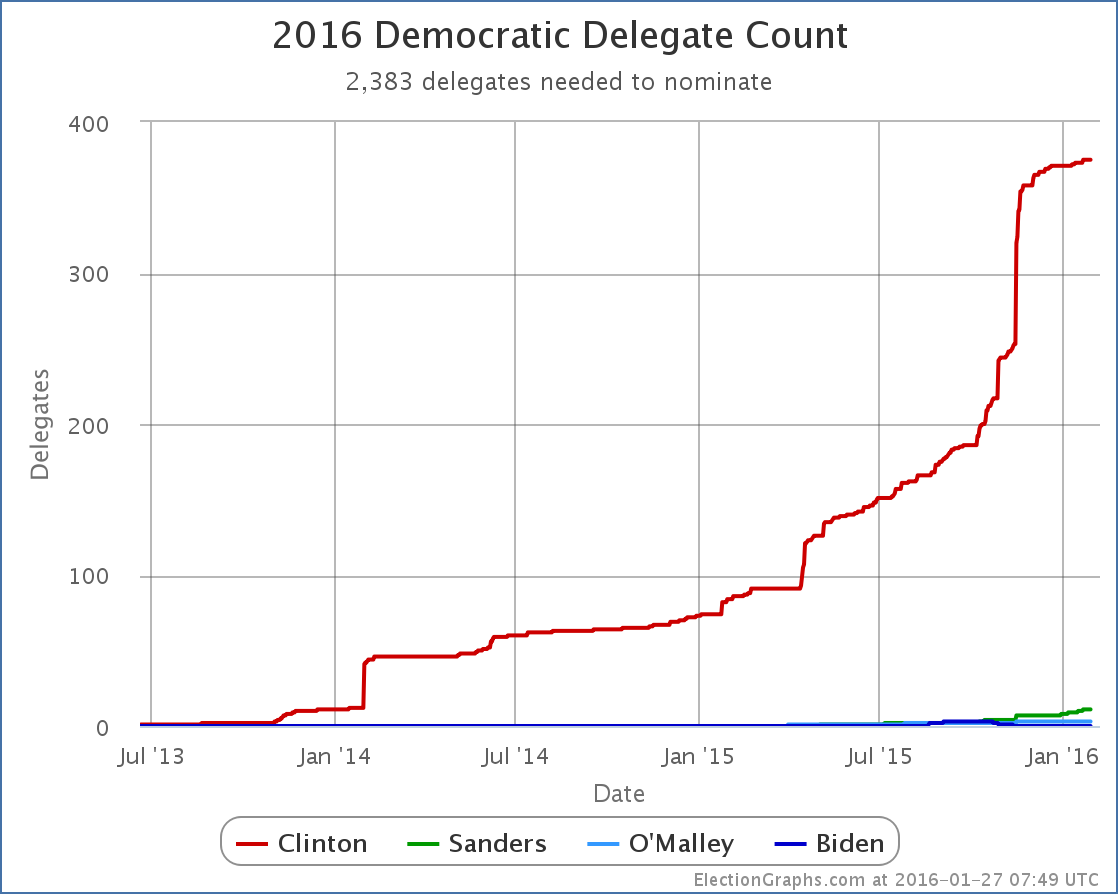
See the red line? That is Clinton. See the Green line? That is Sanders. Clinton is absolutely dominant here.
By my best count, 389 of the 713 superdelegates have expressed a preference, and 375 of those have come out for Clinton. Sanders has 11. O’Malley 3.
Now, the chart above is by date. It looks all jumpy because the delegates revealed their preferences at various random times, with a few big jumps when things happened, like Clinton officially announcing, or when AP did a survey of all the superdelegates. That can be interesting, but actually distorts the picture of how the race is coming along. Time to do a quick switch and show how this looks when we look at the % of delegates allocated instead of the date:
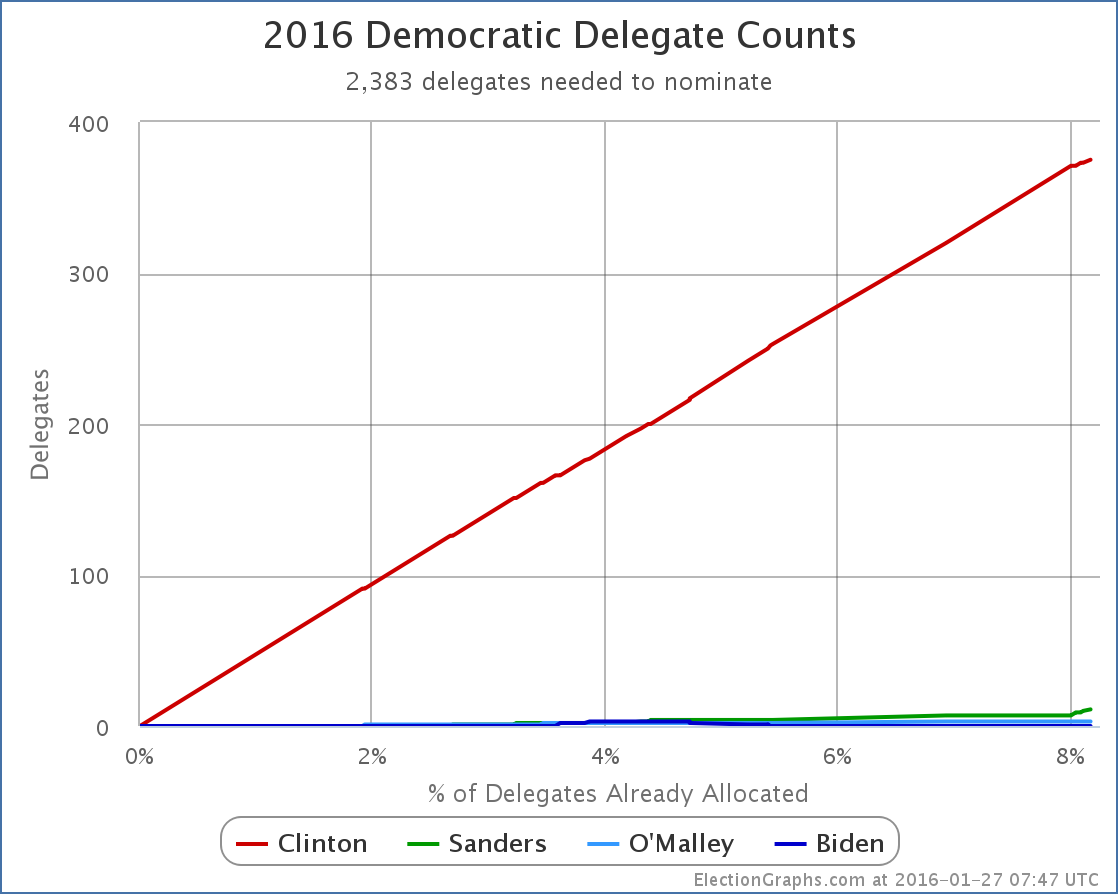
Suddenly, we have nearly a straight line. The lumpiness caused by the uneven distribution of delegate preference announcements over time is gone and we get a much clearer look at what is happening. We see that over 8% of the delegates to the convention have already expressed a preference. Clinton has been consistently racking these up as they come in. She is dominating in this race. But by how much? Lets switch to looking at the % of delegates each candidate has…
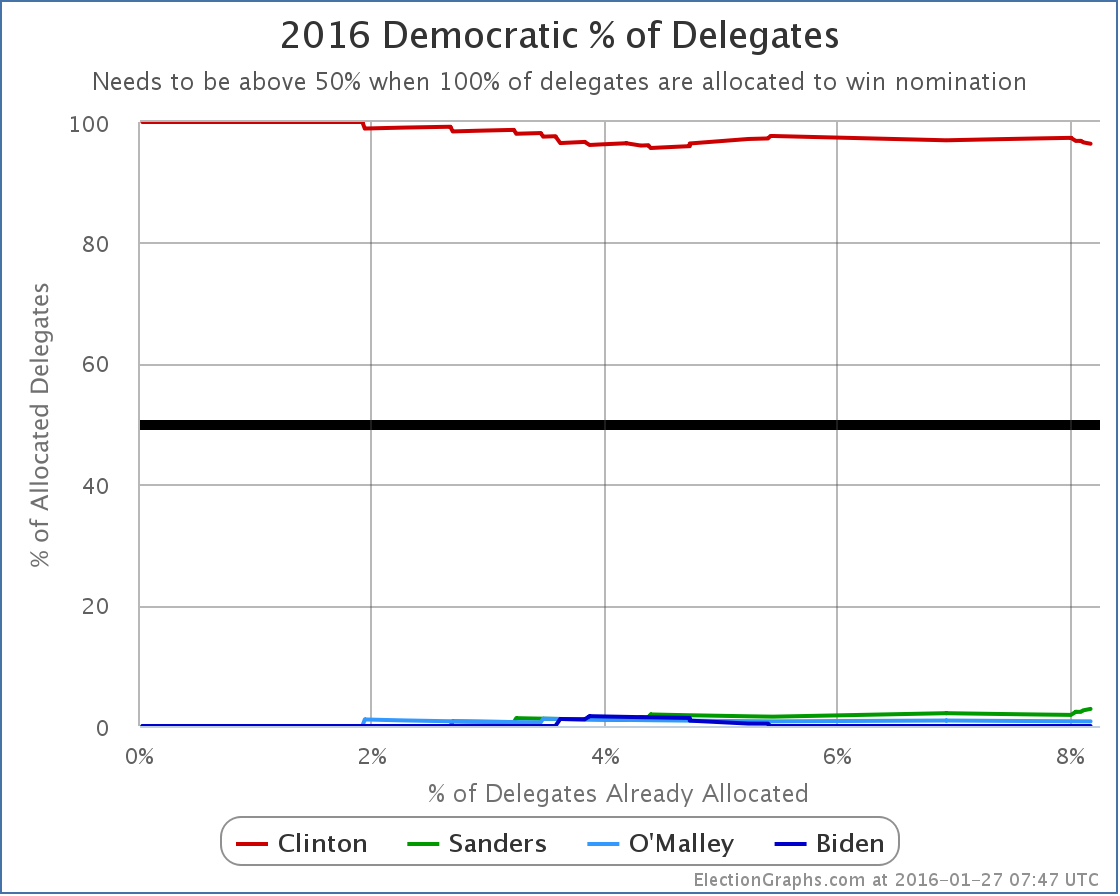
Once again we see that Clinton is dominant, but a few more details start to be seen. For instance we see that so far at least, Clinton’s weakest point was between the 4% and 5% marks when Biden, Sanders and O’Malley all had a few delegates in their columns and Clinton had about half the delegates she has today. But Biden dropped out, and Clinton kept on getting delegates at a pace not matched proportionately by Sanders or O’Malley, so Clinton’s dominant percentage increased again for awhile.
Very recently though, at the tail end of this chart, you can see that Sanders has been collecting delegates at a fast enough pace that his percentage has actually been going up, while Clinton’s has been decreasing. The Sanders percentage is still small, but it is going up. So where does that put Sanders? How about his surge? Can he win?
Time to look at the chart I consider to be the most important one to look at for understanding the race. Instead of looking at the percentage of delegates each candidate already has, we shift to looking at the percentage of the remaining delegates that the candidate would need to get in order to win the nomination:
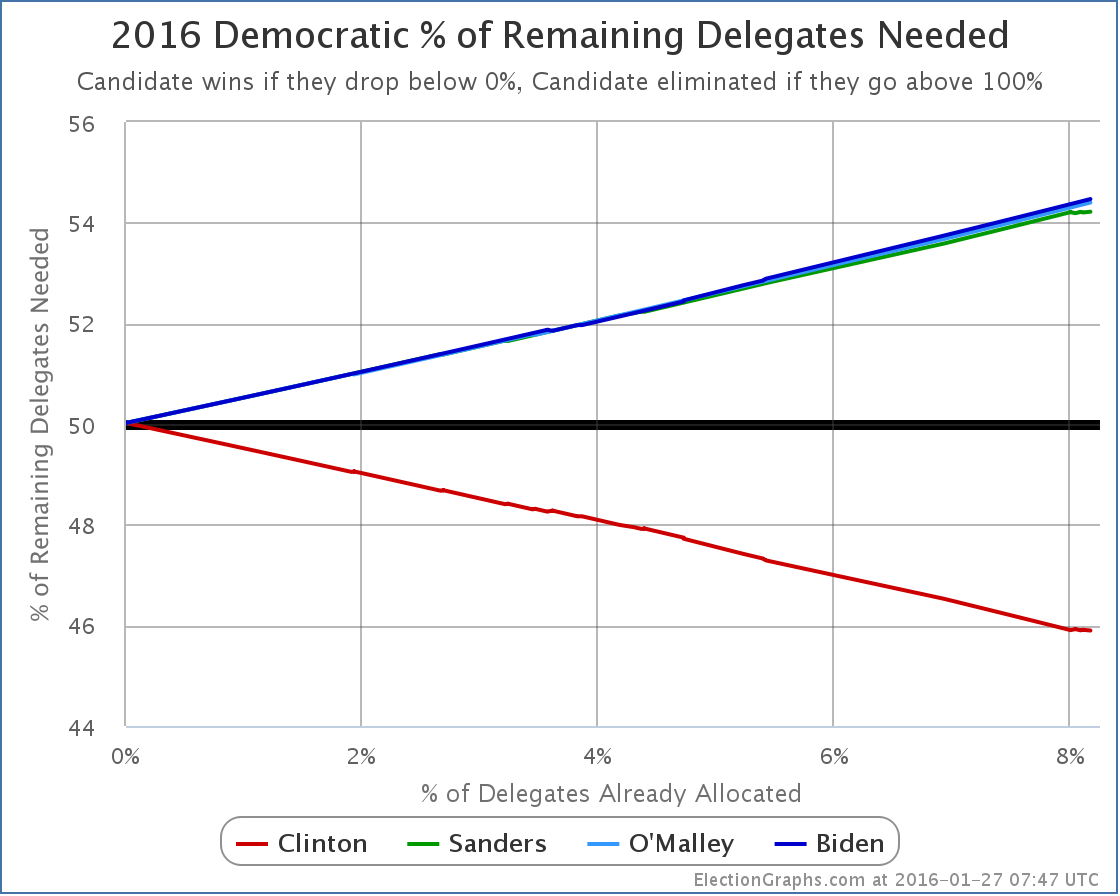
As Clinton racks up delegates, it becomes harder and harder to catch up. With the lead she already has based on superdelegates, in order to win, Sanders doesn’t need to get 50% of the remaining delegates, he needs to get 54.22% of the remaining delegates.
Specifically looking at Iowa, 44 delegates are at stake.
To be clear, no Democratic delegates will actually be earned on the night of the Iowa caucus. It is the first step of a multi-stage process that won’t end until June. But after the precinct caucus results next week, we’ll be able to make estimates based on the initial vote results and what we know about the specific delegate allocation rules in Iowa.
With 44 delegates up for grabs, given the 54.22% number we calculated, for Sanders to actually put himself in a better position after Iowa than before, Sanders doesn’t need 22 or 23 delegates, he needs 24.
Now, if Sanders gets more delegates than Clinton, the media and press coverage about the Sanders surge and the risk to Clinton will be overwhelmingly loud. Nobody other than this site will be talking about how he won, but didn’t get to 24, so he is actually worse off. Everything will be about the Sanders win and his “momentum”.
And there is some fairness to this. If Sanders wins Iowa’s popular vote, no matter what the delegate estimates turn out to be, he will get a lot of positive attention. And people will talk about how Clinton is a lot weaker than she had seemed. That talk may improve Sanders’ position in New Hampshire or in other states further down the road. Perhaps it would boost him enough to compensate for the increase in the “% of remaining needed to win” that would result from falling short of 54.22% in Iowa. Getting a narrow win that doesn’t get enough delegates to actually improve the overall position in the short term may actually still have a positive impact in the medium to long run. Spin matters.
The polls are close in Iowa, either Clinton or Sanders could easily take the state. But the numbers to watch are not the popular vote totals. You shouldn’t even be looking simply at who is estimated to get the most delegates. The question is if the person who gets the most delegates gets enough to be on pace to win.
For someone other than Clinton to win, they have to start by catching up. This already means that they have to get more than 54% of delegates as we go forward. If they fail to reach that number, with each subsequent contest they will have to do even better to catch up.
If they do reach that bar though, each subsequent contest becomes easier. That’s the way it works. But the target is not getting the most delegates in each contest. It is getting more than the number you need to be on pace to win. Right now Sanders needs 54.22% of the delegates. Clinton only needs 45.90% of the delegates. She doesn’t even need to get a majority since she has already banked so many delegates before voting even starts.
So far, in the “invisible primary”, Clinton has scored an incredible 96.4% of the delegates. This will not continue. The Democratic leaders that make up the superdelegates have a very different perspective and background than Iowa caucus goers, or New Hampshire primary voters. Sanders will do better than the 2.8% of delegates he has managed so far. The question is how much better and if it puts him on track to actually catch up and win, or if it quickly becomes apparent that he is just playing the role of the protest candidate almost everyone originally expected him to be.
If Sanders doesn’t get to that 54.22% mark in Iowa, we may know pretty quickly that he is falling short, although if he wins in the popular vote, there will still be a crazy media circus for weeks.
If he exceeds that mark though, then the media howling might actually be warranted. At least until South Carolina. South Carolina is a very different state than either Iowa and New Hampshire, and the picture might change dramatically again after that.
But the next few weeks will be exciting almost any way the results go. And we haven’t even talked about the Republicans this time since there aren’t any delegates to look at quite yet. There will certainly be quite a bit of excitement on that side as well.
Tune in here for all the twists and turns as this race shifts into high gear!
Just under a week until Iowa. Hold on tight.
Note: This post is an update based on the data on ElectionGraphs.com. Election Graphs tracks both a poll based estimate of the Electoral College and a numbers based look at the Delegate Races. All of the charts and graphs seen in this post are from that site. Additional graphs, charts and raw data can be found there. All charts above are clickable to go to the current version of the detail page the chart is from, which may contain more up to date information than the snapshots on this page, which were current as of the time of this post. Follow @ElectionGraphs on Twitter or like Election Graphs on Facebook to see announcements of updates or to join the conversation. For those interested in individual general election poll updates, follow @ElecCollPolls on Twitter for all the polls as they are added.
[Edit 06:45 UTC to fix wording]
[Edit 08:09 UTC to update graphs]
[Edit 08:15 UTC to fix typo]
[Edit 2016-02-02 06:03 UTC to change “Delegate Race” in title to “Democrats” in preparation for separating posts on the two races]
On Curmudgeon’s Corner this week, Sam and Ivan talk about, what else, the presidential race. On the Republican side: What is up with Sarah Palin? Does Trump really represent conservatism? That Cruz eligibility thing. And more. On the Democratic side: Does Sanders have a chance? Will Clinton’s negativity backfire? The Idealism vs Pragmatism conflict. And more. Then a sharp turn away from politics and for some reason they talk about Star Wars for 15 minutes. Shrug. Oh yeah, and WiFi sucks.
Click below to listen or subscribe… then let us know your own thoughts!

Recorded 2016-01-22
Length this week – 1:25:39
 1-Click Subscribe in iTunes 1-Click Subscribe in iTunes
 View Podcast in iTunes View Podcast in iTunes
 View Raw Podcast Feed View Raw Podcast Feed
 Download MP3 File Download MP3 File
 Follow the podcast on Facebook Follow the podcast on Facebook
Show Details:
- (0:00:10-0:03:41) Intro
- Agenda
- Listener Request
- Boring Lives
- (0:04:21-0:42:31) Election 2016 – Republicans
- Sarah Palin
- WiFi Sucks
- Sarah Palin again
- Trumpism and Palinism vs Conservatism
- Establishment coming around to Trump?
- Dynamics approaching Iowa
- Will anybody stop Trump?
- Cruz eligibility
- Trump foreign policy
- (0:43:34-1:07:13) Election 2016 – Democrats
- Clinton will win…
- …unless she screws it up
- Negativity backlash?
- Base vs Centrist divide
- Embracing Obama
- Iowa and New Hampshire
- Hillary in trouble freakout
- How might Clinton blow it?
- Sanders vs Trump?
- National Review’s anti-Trump issue
- (1:08:23-1:25:19) Star Wars Lightning Round
- Movie: Star Wars – The Force Awakens (2015)
- Lucas Sour Grapes
- What was wrong with the prequels?
- Where is Rey?
- Kylo Ren
- Feedback
On this week’s Curmudgeon’s Corner, Sam and Ivan catch up with the developments of the last few weeks for the Presidential race. They cover all the dynamics on the Republican side, and discuss if Sanders really is a threat to Clinton on the Democratic side. In the lightning round, a round up of some other recent news… Chinese markets, Iran and Saudi Arabia, CES, Y’all Qaeda in Oregon, book and TV show reviews, and more!
Click below to listen or subscribe… then let us know your own thoughts!

Recorded 2016-01-14
Length this week – 1:36:59
 1-Click Subscribe in iTunes 1-Click Subscribe in iTunes
 View Podcast in iTunes View Podcast in iTunes
 View Raw Podcast Feed View Raw Podcast Feed
 Download MP3 File Download MP3 File
 Follow the podcast on Facebook Follow the podcast on Facebook
Show Details:
- (0:00:10-0:14:19) Intro
- (0:15:07-0:42:25) Election 2016 – Republicans
- Internet Slowdowns
- Iowa Polls
- Trump’s Cruz Birtherism
- Likely Voter Models
- Rapid Poll Movements
- Kasich surge?
- Debates
- Candidates Dropping Out
- Contested Convention scenarios
- State by State Delegate Rules
- (0:43:02-0:59:45) Election 2016 – Democrats
- More on Republican delegate allocation in Iowa and New Hampshire
- Clinton lead slipping
- Why the late Sanders surge?
- What if Clinton loses both Iowa and New Hampshire?
- Clinton superdelegate advantage
- Media bias toward a close race
- Possible Clinton meltdowns
- Trump’s position vs Clinton’s position
- (1:00:48-1:36:39) Lightning Round
- Book: Conversations with Myself
- TV Series: Star Trek (TOS) [1966-1969]
- If you disagree, you just aren’t listening
- Iran / Saudi Arabia
- Iran and the Navy boats
- CES
- Y’all Qaeda
- Secretary Carter’s Email
- Twitter Character Limit
- Other things we missed
Another day with more Iowa and New Hampshire polls. This time no status changes in the five best polled candidate combinations in New Hampshire, but there were a couple of changes to talk about in Iowa. One of these favors Clinton, the other favors her Republican opponent. Lets take a look.
Clinton vs Trump
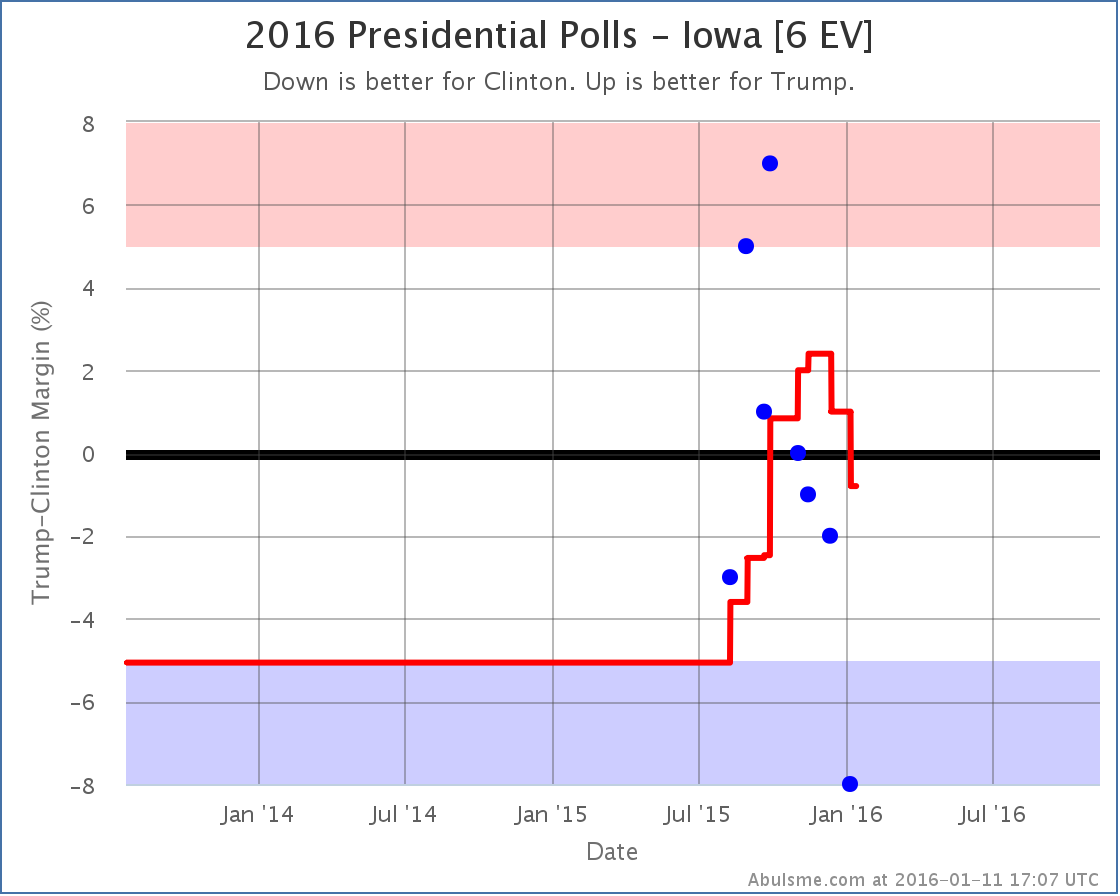
At the end of September after a series of good polls vs Clinton in Iowa, Trump had taken the lead in the Iowa poll average. Since then Trump hasn’t done quite as well, and with today’s addition of a Marist poll showing Clinton with up by 8%, the poll average once again shows a Clinton lead in Iowa.
Clinton’s is only ahead by 0.8%, which means Iowa is still close and could easily go either way. The five polls included in the average range from Clinton up by 8% to Trump up by 7%. That is a pretty big range!
The average puts Iowa in the “Weak Clinton” category though, so we give it to Clinton in the “expected case” for the moment. The updated national electoral college bubble looks like this:
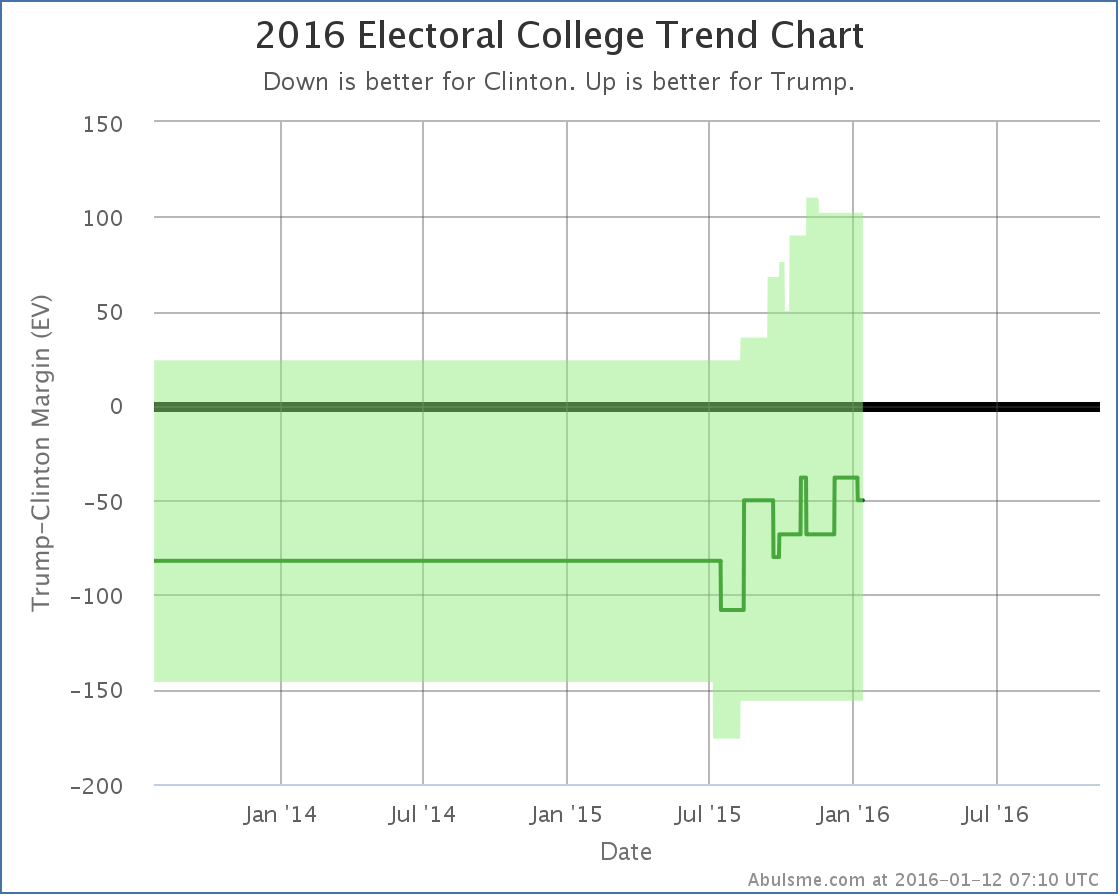
The last tick downward in the green center line is Iowa flipping to Clinton, which puts the “expected” Clinton vs Trump case at a 50 electoral vote Clinton win. But there are many close states still, so anything from a 156 electoral vote Clinton win to a 102 electoral vote Trump win would be within the realm of possibility given current state level polling.
This just goes to reiterate the point I made last month: “Do Not Underestimate Trump“. Conventional wisdom is that if the election comes down to Clinton vs Trump, it would be a Clinton runaway win, but poll data just does not show that right now.
(Insert usual comments here about how far we have until the election and how none of this is predictive yet. It only shows us a bit about how things look NOW, and even then only imperfectly due to the relative sparseness of state level polling.)
Clinton vs Cruz
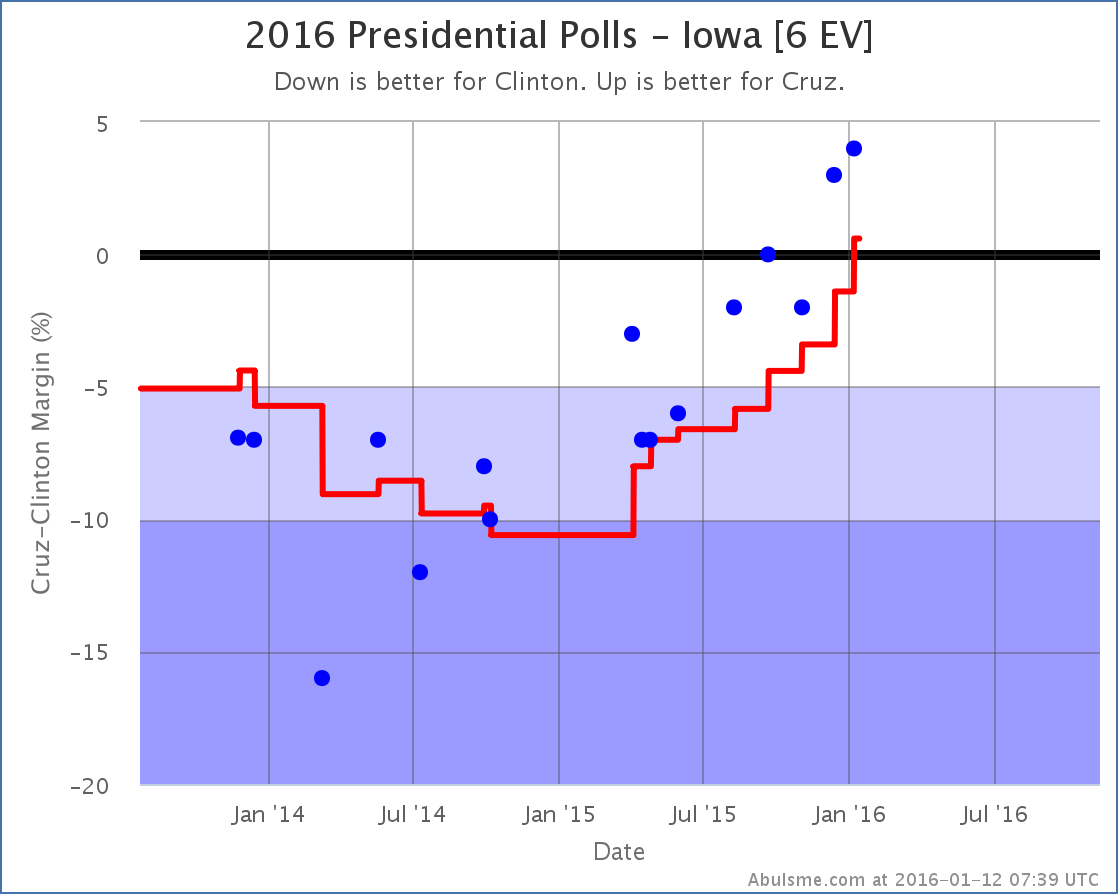
Unlike Trump, who rose for awhile and then has been falling, Cruz has been consistently improving in Iowa for the last year. With today’s update, he takes the lead in the poll average. It is just a 0.6% lead, but it is a lead, and we give him the state for now.
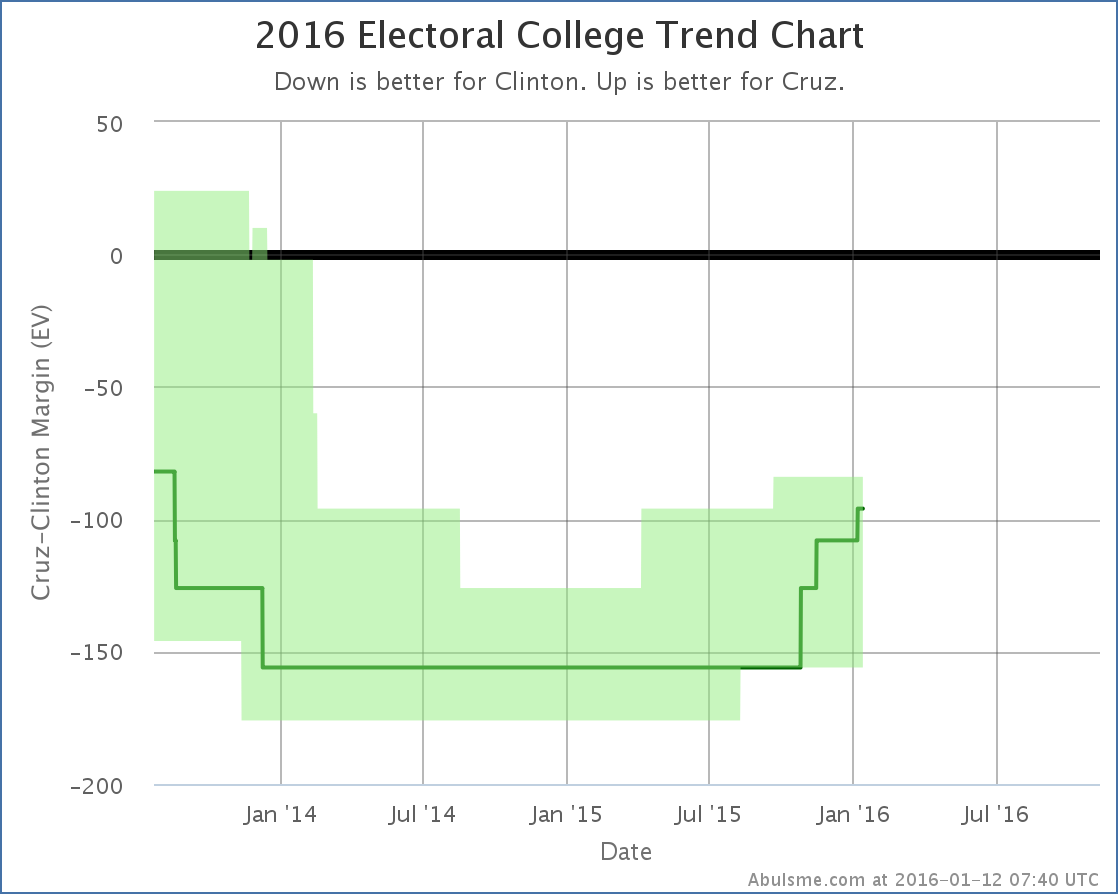
This brings Cruz up to… losing by 96 electoral votes to Clinton. Unlike Trump though, if you give him all the close states as well, it is still a loss to Clinton, just by only 84 electoral votes, which is still a pretty substantial Clinton win. Right now, Cruz is not “within range” of Clinton, while Trump is.
This is based on state level polls though, which at this point in the cycle lag national polls. The RCP average for Clinton vs Cruz shows Cruz ahead at the moment. If there indeed is a big enough move toward Cruz that he starts to be competitive, it will show up in the state level polls soon enough. That isn’t evident from the state data yet, but I can say that Cruz is competitive in Iowa, and currently has a very slight lead there.
Others
I don’t talk much about candidate combinations beyond the top five best polled, as their polling data is generally sparser, but just to note them in passing… Today’s batch of polls also flips New Hampshire from Clinton to Rubio, strengthens the Sanders lead over Cruz in New Hampshire, and moves the national tipping point in Sanders vs Trump further toward Sanders.
We’re going to see the pace of polling increasing dramatically as the primary season gets underway. As soon as we have clear front runners in both parties, we’ll stop seeing any polling at all for the other candidates and it will all be about the final general election match ups. Over the next couple months we’ll get to see just how quick that transition is.
301.7 days until the general election polls start to close.
Note: This post is an update based on the data on ElectionGraphs.com. All of the charts and graphs seen here are from that site. Graphs, charts and raw data can be found there for the race nationally and in each state for every candidate combination that has been polled at the state level. In addition, comparisons of the best polled candidate combinations both nationally and each in each state are available. All charts above are clickable to go to the current version of the detail page the chart is from, which may contain more up to date information than the snapshots on this page, which were current as of the time of this post. Follow @ElecCollPolls on Twitter for specific poll details as I add them. And like Election Graphs on Facebook!
|
|

















